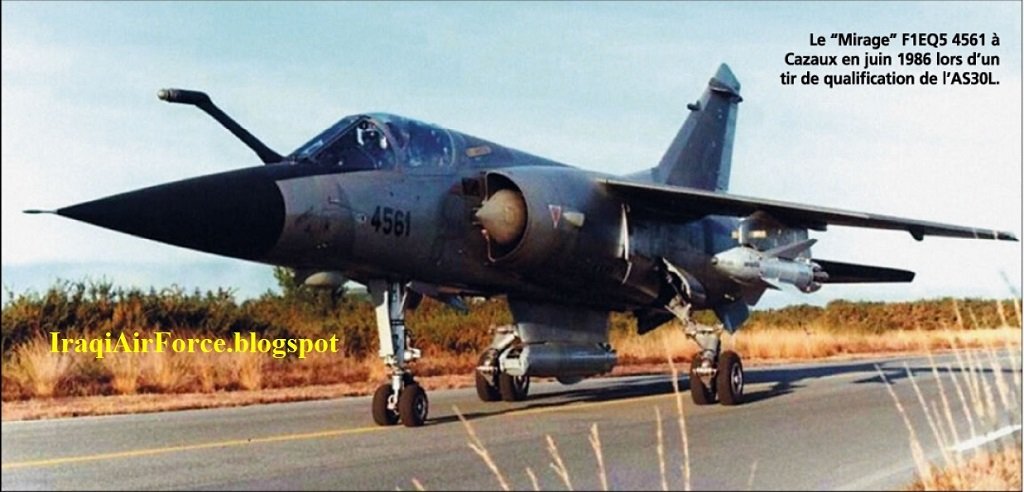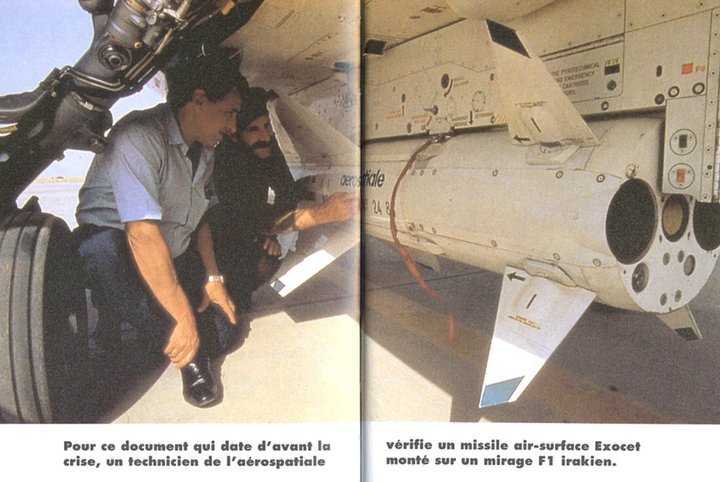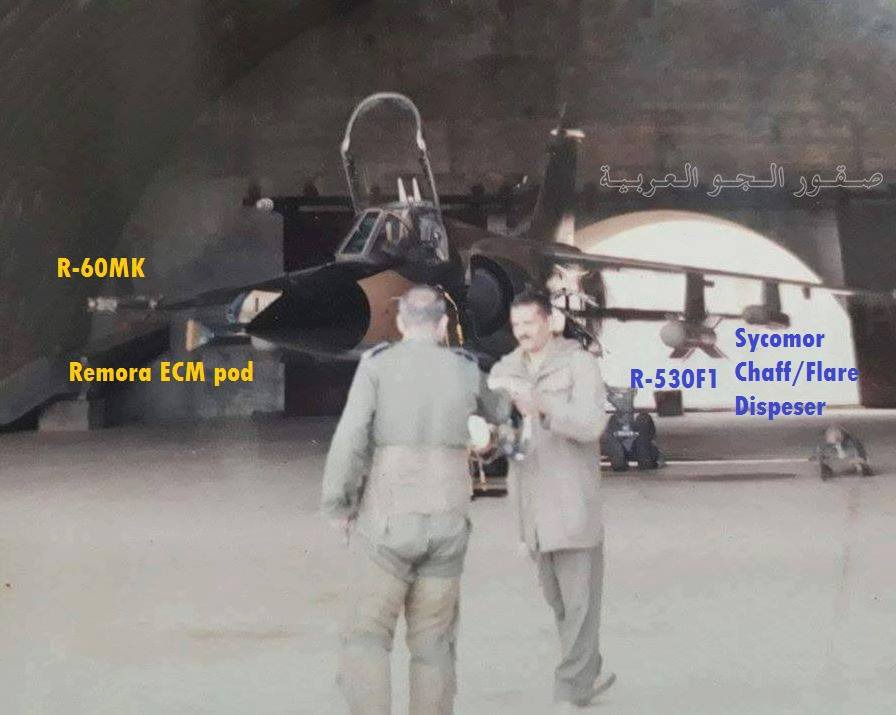- Yes, don’t care how
- Yes, as a researchable vehicle
- Yes, as a premium/event/squadron vehicle
- No
- France
- United Arab tree
- Other
- I said no
Hello everyone, in this topic we’ll be having a look at the first real multirole version of the Mirage F1, a version built specifically for Iraq: the Mirage F1 EQ5
The F1 EQ5 is one of the penultimate versions of the successful Mirage F1 family. This version was derived from the standard Mirage F1E, E in this case stands for Export, but sits at the very end of a line of increasingly capable versions made specifically for Saddam Hussein’s Iraq. Iraq started using the Mirage F1 in 1980 with an order of 16 Mirage F1EQs, this was followed by an additional order for 16 F1EQ-2s which were delivered from 1981 onwards. The 16 existing EQs were also upgraded to the EQ-2 standard. The next version was the EQ-4, the first Iraqi-operated version that also featured the iconic refueling boom. Much of this standard would later be used as a basis for the French F1CT standard. Then from 1983 to 1985, the Iraqi air force gets its first Mirage F1 EQ-5s. This version was specifically designed for anti-ship and anti-ground operations and was more advanced and capable than any Mirage F1 that France itself ever operated. Between 1988 and 1990, Iraq would receive another 18 Mirage F1s, these were of the EQ-6 standard, an even more advanced (albeit only slightly) version that I will try to cover in a separate suggestion.
As mentioned, the EQ-5s were quite advanced and capable aircraft, and they can actually be regarded as the first truly multirole versions of this aircraft. As such, you might wonder why France never chose to operate them themselves, instead opting for the more humble CT standard. However, the time of development of the EQ-5 and 6 in the mid to late 80s corresponds to the development of Mirage 2000 strike variants such as the 2000D and N. While these only entered service in the 90s, France chose to bridge the gap with the CT which could deliver guided munitions but needed a buddy aircraft to provide laser designation for it, this would be done by the Jaguars first and the 2000D/N itself later on. Unlike its French cousins though, the Mirage F1 EQ-5 did not need another aircraft to designate targets for it. These F1s had the ability to carry a unique LDP that was derived from the ATLIS pod in use by France. This pod is known as the LDP1 EQ Patrick and although it looks a bit different from a standard ATLIS, it’s functionally almost identical. With this, the F1 EQ-5 could deliver precision-guided munitions such as the AS-30L (see image below), BGL-1000, and even the AM-39 Exocet.
From 1988 onwards, the Iraqis also added another guided weapon to the arsenal of the F1 EQ-5 and 6, the Kh-29L (as seen in the header image). This was because Matra stopped deliveries of the AS-30L in mid-1988 because the Iraqis had not paid for the remaining missiles. The interim solution they found was to make the stock of Kh-29L missiles that they already had compatible with their Mirages, with a rather curious combination as a result. The payment dispute was eventually settled in late 1989 and deliveries of the AS-30L resumed.
As mentioned before, the aircraft was also capable of firing the AM-39 Exocet missile. This was a key point of the aircraft as a large part of its missions would be anti-shipping. This compatibility was added thanks to a new radar, the Agave. In this role, the aircraft became rather famous with a great deal of success against ships in the Persian Gulf. More than 100 ships had been attacked between 1984 and 1988, 37 of which were sunk by Exocet armed Mirage F1s. One of the more famous incidents was the attack on the USS Stark in 1987, which lead to severe damage to the American ship. The F1 EQ-5 was capable of carrying one Exocet missile, as seen in the image above, this missile was mounted to the underbelly hardpoint. Later F1 EQ-6s would be able to carry 2 Exocet missiles under its wings.
Until now we’ve only talked about the air-to-ground and air-to-sea capabilities of the EQ-5, but since it’s a multirole fighter, it was also very much still capable of performing anti-air duties. The Cyrano IVQ/C5 radar still had the same air-to-air capabilities as the other Mirage F1 variants (bar the F1A of course). As such the aircraft was able to use all air-to-air weapons that France also used on its F1s: Magic I, Magic II, and Super 530F. During the 1990 invasion of Kuwait, Iraqi Mirage F1s were credited with 35 aerial victories in the opening stages of the conflict. Later, as the international community stepped in, Iraq and its F1s would take heavy losses when going up against much superior aircraft such as the F-15C.
General Characteristics:
Crew: 1
Length: 15.3 m
Wingspan: 8.4 m
Height: 4.5 m
Wing area: 25 m2
Empty weight: 7,400 kg
Gross weight: 10,900 kg
Max takeoff weight: 16,200 kg
Powerplant: 1 × SNECMA Atar 9K-50 afterburning turbojet engine, 49.03 kN thrust dry, 70.6 kN with afterburner
Maximum speed: 2,338 km/h at 11,000 m
Maximum speed: Mach 2.2
Combat range: 425 km hi-lo-hi at Mach 0.75/0.88 with 14 × 250 kg bombs
Ferry range: 3,300 km with maximum external fuel
Endurance: 2 hr 15 min (combat air patrol, with 2 × Super 530 missiles and centreline drop tank)
Service ceiling: 20,000 m
Rate of climb: 243 m/s
Thrust/weight: 0.66
RWR: Yes, BF radar warning receiver
Radar: Yes, Cyrano IVQ/C5
CCIP/CCRP: Yes
Flares/chaff: Yes, in Phimat or Sycomor pods carried under the wings on the outer hardpoint.
LDP: Yes, LDP1 EQ Patrick with regular and IR modes (same modes as found on French ATLIS pod)
Armament:
Guns:
- 2x 30mm DEFA 553
Unguided bombs:
- Up to 8x 250kg SAMP type 25
- Up to 8x 400kg SAMP 400 type 21
Rockets:
- Up to 4x SNEB 36x launcher
- Up to 4x SNEB 18x launcher
Guided bombs:
- Up to 2x BGL-1000 laser-guided bombs.
ATGMS:
- Up to 2x AS-30L
- Up to 2x Kh-29L
- 1x AM-39 Exocet
Air-to-air missiles:
- 2x magic I (wingtip pylons)
- 2x magic II (wingtip pylons)
- 2x R-60MK (wingtip pylons)
- 2x super 530F (inner wing hardpoints, same as on F1s in game)
Function in game:
The Mirage F1EQ-5 offers something quite unique, a capable air-to-ground platform based on the Mirage F1. With a guided armament package that is quite similar to the Jaguar and the extra performance of the Mirage F1, we have an aircraft that is unlike any currently in game. The way I see it there are 2 ways to implement this aircraft. Either It is added between the Mirage F1CT and Mirage 2000D as a researchable vehicle or it is implemented as a premium (for example to replace the lackluster F1C-200). The first option would allow for an extra researchable air-to-ground platform with guided munitions to bridge the gap between the Jaguar at 10.3 and the Mirage 2000D at 11.3. Yes, there are 2 aircraft between those 2 but both of them are incapable of delivering guided munitions which somewhat limits their effectiveness. For this, of course, we’d have to see the Mirage F1s drop to a battle rating below that of the Mirage 2000s (something that seems logical but as of right now hasn’t happened). As a premium, the F1EQ-5 could offer a much more interesting alternative to the F1C-200. While it retains the air-to-air options of the former, it also adds the aforementioned a2g options which could also make it an interesting buy for people looking to bolster their ground lineups. Relegating it to the premium role would also not necessarily take anything away from the tech-tree as the slightly more advanced EQ-6 variant can still be implemented as well. The third option would be to implement the F1EQ-5 in some sort of unique tree, this could be something like a pan-Arab tree, this option to me seems less likely but only time can tell how it will turn out.
Sources
https://drive.google.com/file/d/1VXa4WDLuRAs1p_wIseZM40BZqYhMQRz0/view
https://media.defense.gov/2010/Sep/27/2001329817/-1/-1/0/AFD-100927-066.pdf
http://les-heros-de-bagdad.over-blog.com/
Mirage F1 Persan aux cocardes peu communes - Page 6
https://www.checksix-forums.com/viewtopic.php?t=181481&start=75























